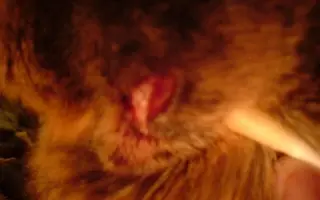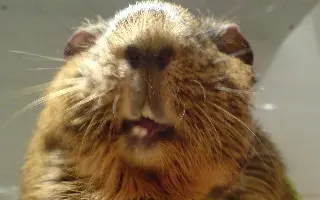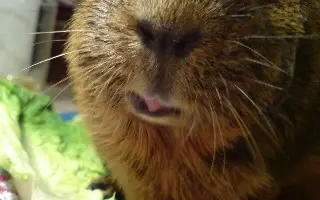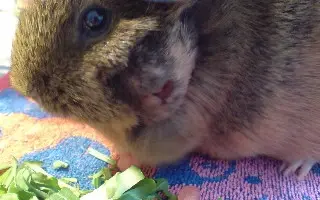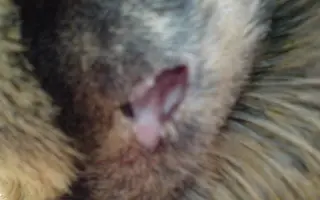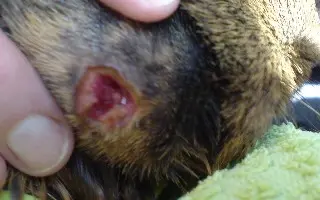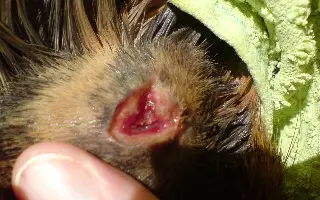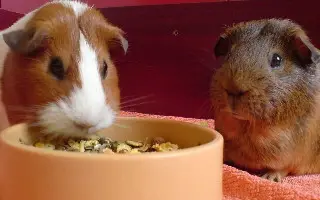Up-Date on Bonnie (warning: contains some graphic descriptions and images)
Following the lancing of her abscess, Bonnie started feeding herself. She has gained weight and looks much perkier. From the horrible distortion that existed on Friday (06/03/09), her incisors are now almost normal. The change has been that quick.
9 am (09/03/2009)
I took Bonnie to the vet this morning. I saw a different vet, one of the senior partners (the third vet in four consultations). He carefully examined her wound, pressing all around it for signs of tenderness or discharge and found none. He said he thought it was healing well and that it should be left to heal naturally but I should finish the course of Baytril to assist nature. No further treatment would be necessary. We agreed a routine of three-monthly check-ups to check Bonnie’s teeth for any recurring problems. No consultation charge. I left feeling great. (See first image - Bonnie apparently cured).
11 am (09/03/2009)
I noticed that Bonnie was scratching her wound. I guessed it was itching as wounds tend to do when they are healing. I gave 0.2 mls Metacam (analgesic) to relieve the itching and stop her scratching the wound and perhaps infecting it. After dosing her I picked up my mobile phone to photograph the ‘cured Bonnie’ for my website and this Forum when I noticed that a thick grey-yellow, foul-smelling discharge was oozing from her wound. (See second image). I was shocked because there had been absolutely no indication of any infection in the wound and both myself and the vet had squeezed 360-degrees around the wound in an attempt to express any latent puss. This discharge seemed to come from nowhere.
I instantly set about cleaning away all traces of this material. I washed the wound with plain water (applied using a 1 cc syringe) and cleaned the wound with cotton buds dipped in brandy. Once I had cleared away debris with the cotton buds, I found a tiny hole at the base of the wound through which the matter appeared to be discharging from some deeper cavity. I knew I had to express all of the puss. I gently but firmly drew the flat of my thumb across Bonnie’s cheek, starting as far back as possible e.g. from the angle of the jaw, from the lower eyelid, from the base of the lower jaw, from the chin – in a 360-degree circle around the wound to express matter from all possible positions. Large amounts of this grey material came out. I washed it all away with copious amounts of water and brandy. I used plain tap water and brandy because this was all I had available to hand. (I later boiled a kettle to make saline solution).
Once these discharges had been cleared, I applied brandy through the syringe to flood the wound and then gently drew back on the plunger to suck any remaining debris out of the wound. After drawing back on the plunger I then flushed the syringe with very hot saline solution (water just off the boil from the kettle, as hot as the plastic of the syringe could take without melting; very concentrated saline -too strong for direct application to the wound) before filling it with brandy and repeating the process. I continued doing this and cleaning away with cotton buds dipped in brandy until all trace of puss or debris was removed.
I found this use of the syringe was a very effective way of cleaning the wound because it drew out hidden puss from the cavity on the other side of the tiny hole, which would otherwise have been impossible to reach (without cutting and I did not have a suitable knife, nor am I sure I’d feel qualified to try cutting). I was careful to ensure that the syringe was never forced into the wound or used to make a vacuum. The cleaning process was quite gentle. However, Bonnie did cry once or twice whilst I was doing this. I realised extreme care was required and tried to be as gentle as possible whilst being determined to clean out all of this infection.
This thorough cleaning process took about an hour. At first I wrapped Bonnie in a towel but she found that uncomfortable after a while and eventually she found a comfortable position standing on the workbench leaning her good side against my chest leaving her wound visible for me to work on. I gave her a small cabbage leaf to chew on as a distraction and it seemed to help. It was reassuring that she was able to eat whilst I was cleaning her wound – at least it was not so painful for her that she could not eat.
After the ordeal, I gave her a cuddle then placed her in her pen with plenty of good things to eat and reluctantly left her there because I had to go to work.
(See third and fourth images).
4 pm (09/03/2009)
During my break at work I was able to get home and check Bonnie and her wound. She seemed quite happy and the wound appeared to be still clean and healthy.
Midnight (09/03/2009)
Back from work. I checked Bonnie and her wound. It appeared to be still clean and healthy. I gave her a meal and she ate it with gusto. I then placed her in her pen where she went straight to the wire to greet the other guinea pigs (I’m keeping them apart until Bonnie’s wound is closed). She seems both physically and mentally far stronger than she has been since her illness began. I am hoping that these signs of recovery are not ‘false dawns’. However, I remember that she appeared just as well this morning at the vet’s and a few hours later a hidden infection became very apparent. I will just remain vigilant and keep inspecting the wound for any signs of puss or returning infection. The one thing that makes me less confident that her wound is really healing is that it still smells bad. A healing wound would not have any smell, certainly not a bad smell.
COMMENT
I hope these notes help others who are caring for their own pets but I want to sound a note of caution. In these postings I describe what I do but I am not prescribing what I do i.e. I definitely do not recommend that others should do the same thing as me. I think you should do whatever your vets advise you to do. I have done the things I have reported here because my vets have not given me good advice about how to care for my pet and therefore I have had to make it up as I go along. Maybe I just don't know how to ask them the right questions to get the answers I need - but the consultations are so short there's very little time to think when you're with the vet.
I have noticed that my vets are good at doing their thing but not good at understanding things from the point of view of the pet-owner. When I take Bonnie to the vets, they describe what they think the problem is, what they think the solution is and then they take Bonnie away into a back room and carry out their part of the procedure, away from my sight. They then hand her back to me as if that were the whole process. But I then have to take her home and look after her. The vets do the surgery and the prescribing of drugs, but I have to do the nursing and the dosing and they never explain how to nurse effectively. That’s why forums like this one are so essential, to make up what is missing in the vet service, support for the pet owner.
Many thanks for your help and support, it is much appreciated.
More images on my temporary website
www.baptistini.info/bonnie.html
